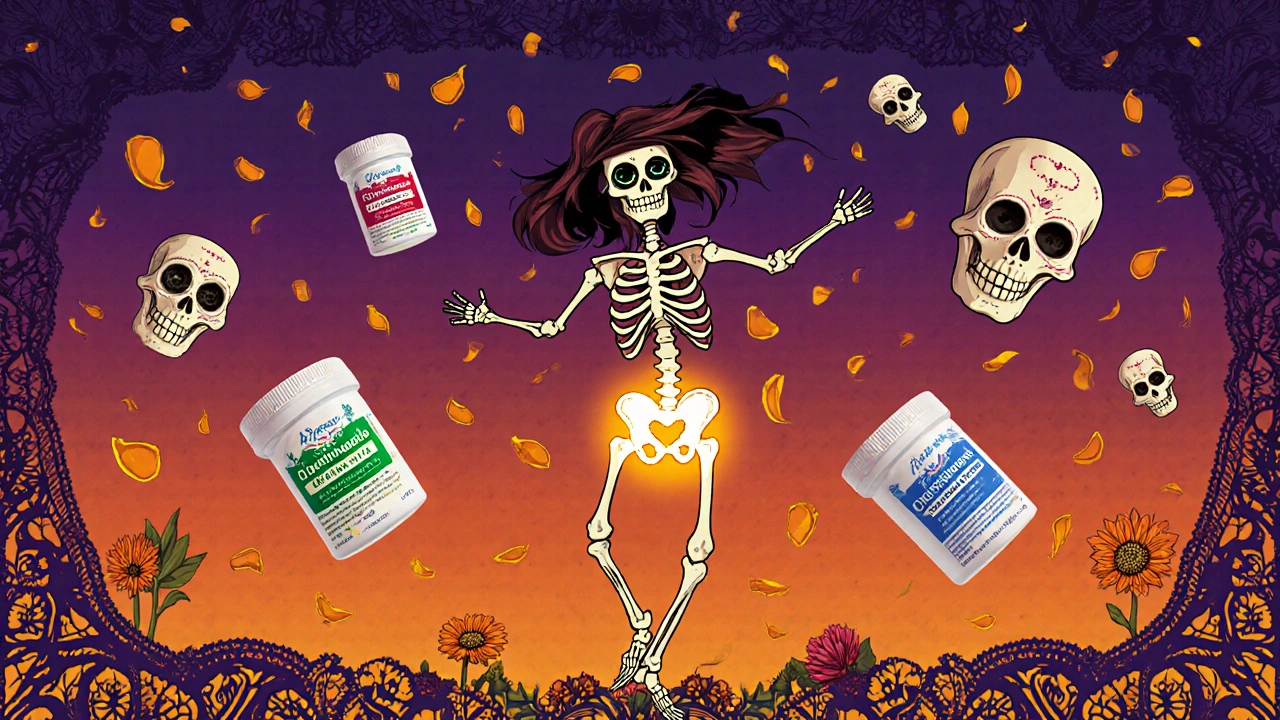
Jock itch isn’t just embarrassing-it’s persistent. If you’ve ever felt that burning, itchy ring of red skin in your groin, you know how quickly it can ruin your day. And no, it’s not caused by being dirty. It’s a fungal infection, usually from Trichophyton species, thriving in warm, sweaty areas. The good news? You don’t need a prescription. Most cases clear up with the right over-the-counter treatment-if you use it right.
What Causes Jock Itch (and Why It Won’t Go Away)
Jock itch, or tinea cruris, isn’t unique to athletes. Anyone with skin folds, sweat, or tight clothing is at risk. Fungi love heat and moisture. That’s why it shows up in the groin, inner thighs, and sometimes near the buttocks. It doesn’t spread through contact with surfaces-it spreads from your own skin, especially if you don’t dry off fully after showering or wear damp underwear for hours.
Many people treat it like a regular rash and reach for hydrocortisone cream. That’s a mistake. Steroids can make fungal infections worse by suppressing the immune response in the skin. You need antifungals-specifically, ones that kill the fungus, not just hide the itch.
Top 10 Over-the-Counter Jock Itch Treatments
Not all antifungal creams are created equal. Here are the 10 most effective, evidence-backed options you can buy without a prescription in the UK and US.
- Clotrimazole 1% cream - The most widely available and studied. Applied twice daily for 2-4 weeks, it clears up 80% of mild cases. Brands like Lotrimin and Canesten are common. Works by disrupting the fungal cell membrane.
- Miconazole 2% cream - Found in Monistat-Derm and Daktarin. Similar to clotrimazole but slightly stronger. Often recommended if clotrimazole doesn’t work after 7 days. Also comes in powder form, which helps keep the area dry.
- Terbinafine 1% cream - Lamisil AT. This one kills fungus faster than azoles like clotrimazole. Studies show it clears infections in 1-2 weeks with once-daily use. Ideal if you want speed over cost.
- Tolnaftate 1% cream or spray - Tinactin and Aftate. Less common in the UK but still effective. Works by blocking fungal enzyme activity. The spray version is great for hard-to-reach areas and doesn’t require rubbing in.
- Butenafine 1% cream - Mentax. A newer option that’s more potent than older antifungals. Used once daily, it often clears the rash in 1 week. Not as widely stocked in pharmacies, but worth asking for.
- Undecylenic acid 25% powder - Desenex. A natural antifungal derived from castor oil. Best for prevention and maintenance. Use it daily after showering to keep the area dry and fungus-free.
- Ketoconazole 2% cream - Nizoral. Originally a prescription drug, now available OTC in many countries. Stronger than clotrimazole, with anti-inflammatory properties. Use only for stubborn cases-it can irritate sensitive skin.
- Hydrocortisone + antifungal combo (e.g., Lotrimin AF with Hydrocortisone) - Only use this for the first 3-5 days if itching is unbearable. The steroid reduces inflammation, but the antifungal does the real work. Don’t use longer than a week. Long-term steroid use can worsen the infection.
- Tea tree oil 10% solution - Not a drug, but backed by clinical studies. A 2022 trial in the Journal of Medical Microbiology showed 10% tea tree oil was as effective as 1% clotrimazole after 4 weeks. Dilute it with a carrier oil if your skin is sensitive. Apply twice daily.
- Coconut oil (unrefined, cold-pressed) - Surprisingly effective. Contains lauric acid, which has natural antifungal properties. A 2021 study in Frontiers in Microbiology found coconut oil inhibited Trichophyton growth in lab tests. Apply a thin layer twice daily. Not as fast as pharmaceuticals, but gentle and safe for daily use.
How to Use These Treatments Correctly
Most people fail because they stop too soon. Fungal infections don’t vanish when the itching stops. The fungus is still there, hiding in skin cells. You need to keep treating for at least 2 weeks-even if you feel fine after 5 days.
Here’s the right way:
- Wash the area with mild soap and water twice a day.
- Dry thoroughly-use a clean towel, then let it air-dry for 5 minutes. A hairdryer on cool setting works too.
- Apply the cream or powder directly to the rash and 1 inch beyond its edge.
- Use it at the same time every day. Set a phone reminder.
- Continue for 1-2 weeks after symptoms disappear.
Don’t wear tight underwear. Cotton is best. Change it daily-or twice a day if you sweat a lot. Avoid sharing towels, gym gear, or clothing. Wash everything in hot water (60°C or higher) with bleach if possible.
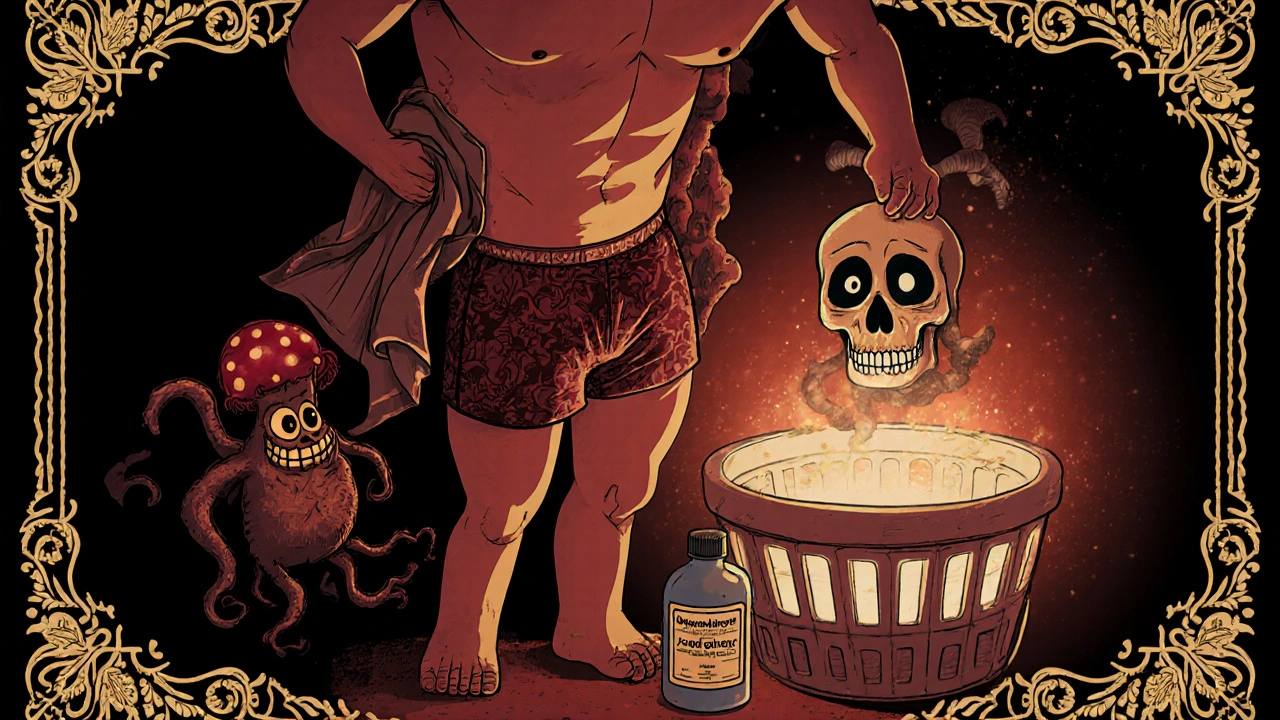
What Doesn’t Work (And Why)
There are a lot of myths out there.
- Antibiotics - They kill bacteria, not fungi. Using them for jock itch is useless and can disrupt your skin’s natural balance.
- Alcohol wipes or vinegar rinses - They sting, but don’t penetrate deep enough to kill the fungus. They can also irritate the skin and make itching worse.
- Essential oils (without dilution) - Oregano, lavender, or clove oil applied straight can burn your skin. Even tea tree oil needs dilution.
- Just using powder - Powders help with moisture, but they don’t kill the fungus. Use them with a cream, not instead of it.
When to See a Doctor
You should get checked if:
- The rash spreads to your genitals, anus, or buttocks.
- It doesn’t improve after 2 weeks of proper OTC treatment.
- You develop blisters, pus, or open sores.
- You have diabetes or a weakened immune system.
Doctors can prescribe oral antifungals like terbinafine or fluconazole if the infection is deep or recurring. They can also rule out other conditions like psoriasis, eczema, or yeast infections-which can look similar.

Preventing Future Outbreaks
Once it’s gone, don’t let it come back.
- Always dry your groin after swimming, showering, or sweating.
- Wear loose-fitting cotton underwear. Avoid synthetic fabrics like polyester.
- Don’t sit in wet gym clothes. Change immediately after exercise.
- Use antifungal powder (like undecylenic acid) daily if you’re prone to outbreaks.
- Keep your bathroom towel separate and wash it every 2-3 days.
- Don’t share shoes or socks-fungus can live in them for months.
Many men who get jock itch repeatedly don’t realize they’re reinfecting themselves from athlete’s foot. If you have foot fungus, treat it at the same time. Put on your socks before your underwear to avoid spreading the fungus upward.
Real Results: What People Actually Experience
One man in Bristol, 38, started using terbinafine cream after two failed attempts with clotrimazole. He’d been dealing with jock itch for 8 months-tried everything. Within 5 days, the redness faded. By day 10, no itching. He kept using it for 14 days. No recurrence in 10 months.
Another woman, 45, used coconut oil after her doctor said she had a mild fungal rash. It took 3 weeks, but she liked that it didn’t burn. She now uses it daily as a preventive.
These aren’t outliers. They’re people who followed the rules: treat long enough, keep it dry, don’t skip steps.
Can jock itch go away on its own?
Sometimes, yes-but it’s risky. Without treatment, the fungus can spread to other areas like your feet or nails. It also becomes harder to treat over time. Most cases need antifungals to clear completely. Waiting it out often leads to recurring outbreaks.
Is jock itch contagious?
It’s not highly contagious like a cold, but it can spread through direct skin contact or sharing towels, clothing, or gym equipment. The fungus thrives in warm, damp environments. If you have it, avoid sharing personal items and wash everything in hot water.
Can women get jock itch?
Yes. While it’s more common in men, women can develop tinea cruris too-especially if they wear tight clothing, sweat a lot, or have diabetes. The symptoms are the same: red, itchy, ring-shaped rash in the groin and inner thighs.
How long does it take for jock itch to clear up?
With proper treatment, most cases improve in 1-2 weeks. But you need to keep using the cream for at least 2 weeks after symptoms disappear. If you stop too soon, the fungus comes back. Severe or recurring cases may take 4-6 weeks.
Can I use antifungal cream on my genitals?
Avoid applying strong antifungal creams directly on the penis or vulva unless directed by a doctor. The skin there is more sensitive. Stick to the outer groin area. If the rash spreads inward, see a healthcare provider-they may recommend a milder treatment.
Does diet affect jock itch?
There’s no strong evidence that sugar or carbs directly cause jock itch. But people with uncontrolled diabetes (which is linked to high blood sugar) are more prone to fungal infections. Eating well supports your immune system, but the main fix is keeping the area clean and dry.
Are natural remedies like apple cider vinegar effective?
Apple cider vinegar has weak antifungal properties in lab tests, but it’s not strong enough to treat an active infection. It can also irritate broken skin. Stick to proven antifungals like clotrimazole or terbinafine. Use vinegar only as a rinse after washing, never as a primary treatment.
Can jock itch lead to other infections?
Yes. If you scratch the area and break the skin, bacteria can enter and cause a secondary bacterial infection. Signs include increased redness, swelling, pus, or fever. If that happens, see a doctor-you may need antibiotics along with antifungals.
Final Tip: Don’t Guess-Treat Right
Jock itch is simple to treat if you know what you’re doing. Pick one proven antifungal-clotrimazole or terbinafine are your best bets. Use it daily, dry the area well, and don’t stop early. Most people fix it in under two weeks. The ones who struggle? They skip steps, use the wrong products, or wait too long to start.
It’s not a shame thing. It’s a fungus. And fungi don’t care who you are. They just want warmth and moisture. Take those away, and you win.
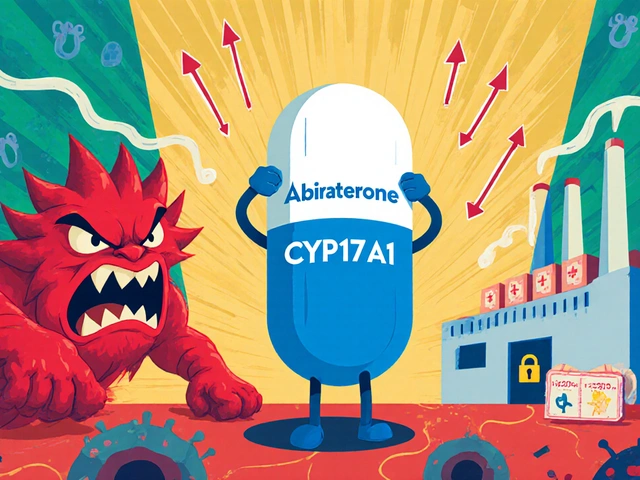
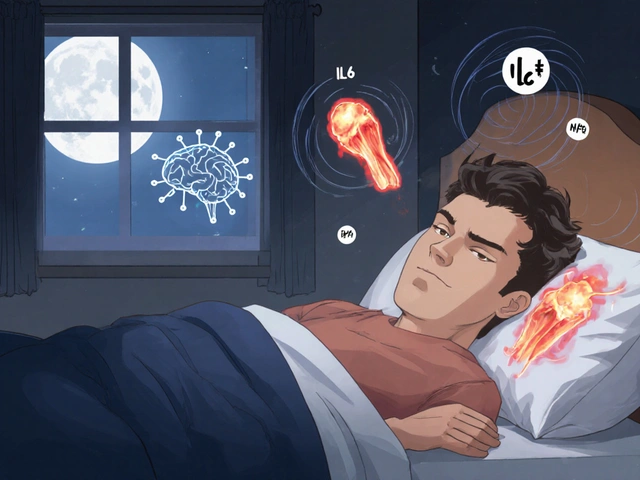
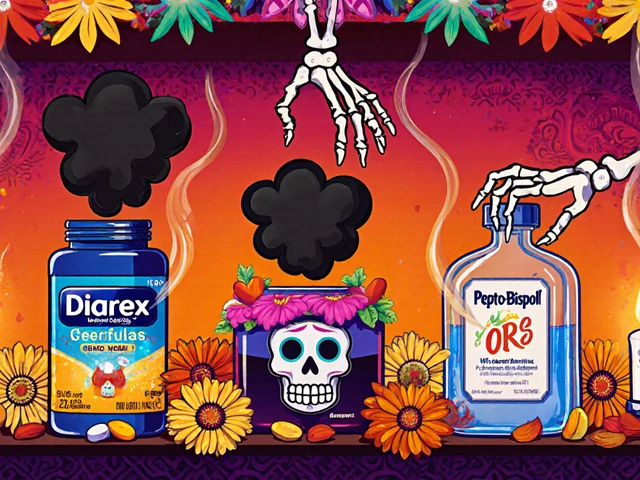
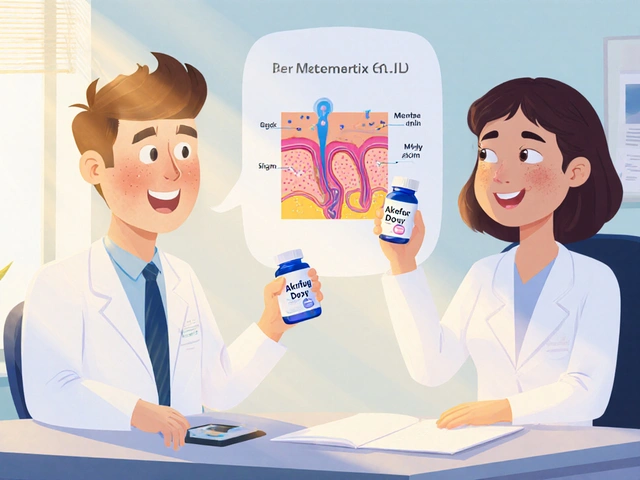
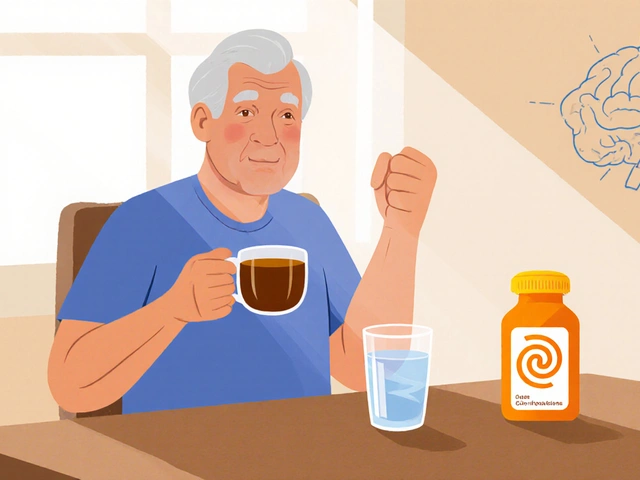
There are 12 Comments
Hannah Machiorlete
I swear I used clotrimazole for a week and thought I was fine, then boom-back in full force two weeks later. Fungi are basically tiny, sneaky little terrorists. I didn’t know I had to keep going past the itching stopping. Total rookie mistake.
Bette Rivas
The clinical evidence behind terbinafine’s efficacy is well-documented in multiple double-blind RCTs, particularly in the British Journal of Dermatology (2020) and the Journal of the American Academy of Dermatology (2019). Its fungicidal mechanism-irreversible inhibition of squalene epoxidase-makes it superior to fungistatic agents like clotrimazole in terms of recurrence rates. For chronic or recurrent cases, a 14-day course with once-daily application is optimal, especially when combined with proper hygiene protocols. Also, the 1% concentration is sufficient; higher concentrations offer no additional benefit and increase the risk of irritant contact dermatitis.
prasad gali
Clotrimazole? That’s what you call treatment? You’re treating symptoms, not the root. Fungi are opportunistic pathogens-they thrive when your immune system is compromised by poor diet, stress, or bad gut flora. You need systemic support. Probiotics. No sugar. Zinc. Vitamin D. Otherwise you’re just playing whack-a-mole with a microscopic enemy that’s been evolving since the Cretaceous. You think cream fixes this? It doesn’t. It just delays the inevitable.
Paige Basford
So I tried the coconut oil thing after reading this and honestly? It worked kind of okay but super slow. Like, 3 weeks slow. But it didn’t burn like the other stuff, so I kept at it. Now I use it every morning as a moisturizer and I haven’t had a flare-up since. Also, I started wearing those cotton boxer briefs from Amazon-game changer. No more sweaty polyester nightmares.
Ankita Sinha
Wait, tea tree oil works as well as clotrimazole? That’s wild. I’ve been using it for my acne and didn’t even think to try it here. I’m gonna mix 5 drops with a tsp of coconut oil tonight and report back. Also, does anyone else feel like jock itch is the modern-day plague of gym bros who never change their shorts? Like, why are we still letting this happen in 2024?
Danielle Mazur
This entire article is a distraction. The real cause? Glyphosate in your food. The same chemical that’s in Roundup and has been linked to fungal overgrowth in the gut. The pharmaceutical industry pushes creams because they make money off recurring symptoms. They don’t want you cured-they want you dependent. Read the FDA’s 2021 whistleblower report on antifungal marketing. It’s not a fungus problem. It’s a corporate poisoning problem.
Herbert Scheffknecht
Think about it: jock itch is just nature’s way of saying you’re too attached to your own comfort. You sit in sweat, you wear synthetic fabrics like a slave to fast fashion, you ignore your body’s signals because you’re too busy scrolling. The fungus isn’t your enemy-it’s your mirror. It reflects your neglect. To cure it, you don’t need cream. You need humility. You need to stop treating your body like a machine and start treating it like a temple. Or at least like something that deserves to be dry.
rachna jafri
Clotrimazole? That’s a Western scam. In India, we’ve been using neem paste for centuries. No chemicals. No patents. Just crushed leaves, turmeric, and a little yogurt. It works better, cheaper, and without side effects. Why are you all paying $15 for a tube of American junk when our grandmothers cured this with kitchen ingredients? This isn’t science-it’s colonial medicine.
darnell hunter
While the provided information contains clinically relevant data regarding topical antifungal agents, the absence of referenced primary literature citations, standardized nomenclature consistent with the International Society for Human and Animal Mycology (ISHAM), and explicit adherence to the 2022 IDSA Guidelines for the Management of Dermatophytosis significantly undermines its evidentiary credibility. Furthermore, the inclusion of coconut oil as a therapeutic agent lacks sufficient peer-reviewed validation at the level of meta-analysis. This document, while superficially informative, constitutes an example of evidence dilution in consumer health media.
Donald Sanchez
bro i used terbinafine and it was like magic but then i forgot to dry my balls after shower and it came back 😭 i’m so dumb. also why is everyone saying coconut oil? i put it on and it felt like i was wearing a greasy diaper. 10/10 would not recommend unless you wanna smell like a vegan curry.
Margaret Wilson
So let me get this straight: you’re telling me I need to use cream for TWO WEEKS after the itching stops… and I thought I was being *responsible* by using it for five days? 😂 I’ve been treating jock itch like it’s a Netflix binge-I stop when I’m bored. No wonder it keeps coming back. I’m officially the fungus’s favorite human.
william volcoff
I’ve had this since college. Tried everything. The terbinafine worked the first time, but I stopped early. Then I tried the tea tree oil, but it burned so bad I cried. Coconut oil? Too greasy. Powder? Doesn’t kill anything. Finally, I started using the cream + powder combo, dried with a hairdryer after every shower, and changed underwear midday at work. It’s been 8 months. No flare-ups. It’s not sexy. It’s not fun. But it works. Do the boring stuff.
Write a comment
Your email address will not be published. Required fields are marked *